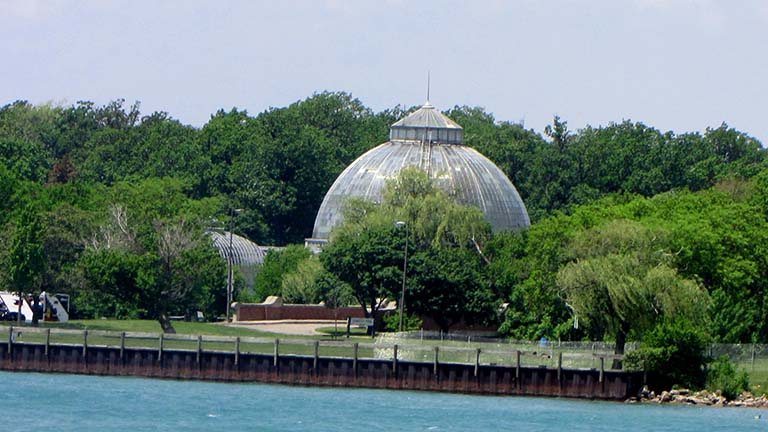

Large parks played an important role in cities in the era before the almost
universal ownership of vehicles. Cities were crowded and very dirty since soft
coal was used to keep factories running and to heat the workmen's homes that
abutted the polluting factories. Early in the 20th century, horses were used
for most local transportation helping to make cities unattractive odorous places.
To get away from the congestion and dirt of the big city, residents could repair to beautiful parks such as Belle Isle. Note only was Belle Isle a place of repose and peace, but it also included facilities that would tell the city's residents about the world outside the city. So it included a zoo and an aquarium. No major park would have been complete without a Conservatory where exotic plants from around the world were on display year round. This Conservatory includes a Palm House, a Tropical Wing, a Fernery/Cacti wing and an extensive collection of orchids. Anna Scripps Whitcomb's name was given to this building in 1953 after she donated her extensive collection of orchids along with money to modernize this class Albert Kahn building.
The City Beautiful movement developed during
and after the Columbian Exposition in Chicago in 1893. It influenced urban
planning throughout
the United States with the hope of both making cities more attractive and providing
urban residents with some rural amenities such as the option of walking on
grass
or picnicking on a greensward. This movement helped to propel prosperous Detroiter
to commission the building of a great Conservatory on Belle Isle. It design
called for it to be surrounded by the gardens that you now see. Those to
the
southwest side of the Conservatory are particularly attractive in summer and
early fall since they surround Marshall Frederick's magnificent Levi L. Barbour
Memorial Fountain with this graceful leaping gazelle. With some frequency,
the
great park designers of the late 19th century placed beautiful park buildings
in garden settings.
Not surprisingly, Albert Kahn was chosen to design the Conservatory. Note its attractively proportioned central dome and the flanking symmetrical wings with their complimentary rounded arches. The design for this conservatory was strongly inspired by the design used for the Conservatory at the Columbian Exposition that took place a decade earlier. This building is best appreciated when viewed with the warm early morning summer sun is reflected off its dome.
Architect: Albert Kahn working at this time with the Nettleton
and Kahn and
Mason and Kahn firms.
Date of Completion: 1904
Date of Rebuilding: Mid-1950s
Websites: http://dir.gardenweb.com/directory/aswc
http://www.bibsociety.org/sys-temp/door
Picture: Ren Farley
Description updates: July, 2012